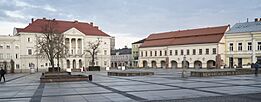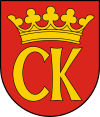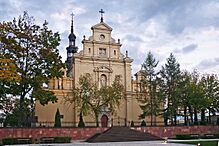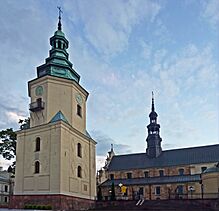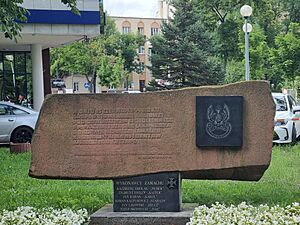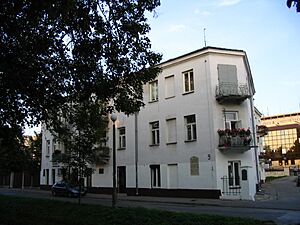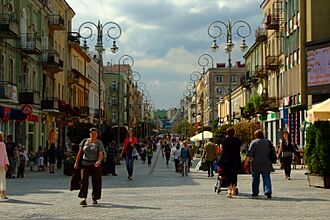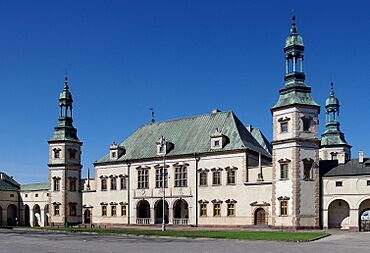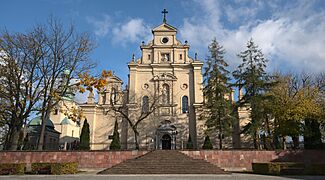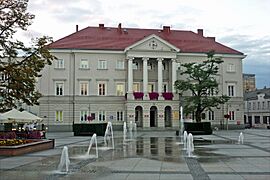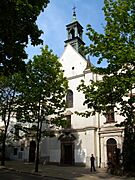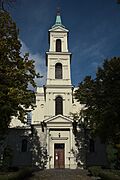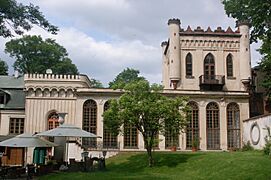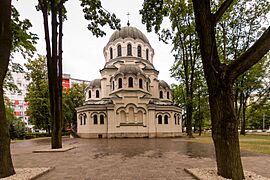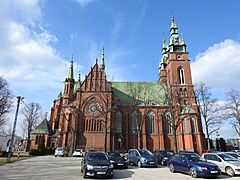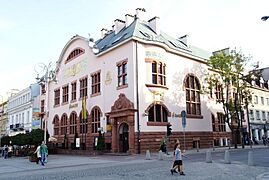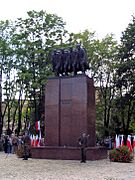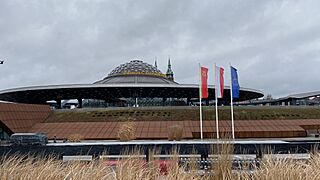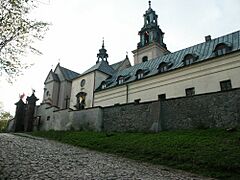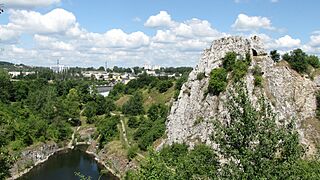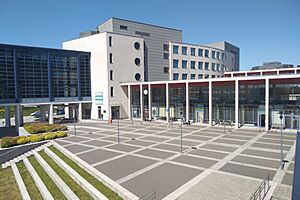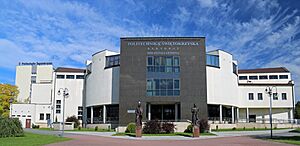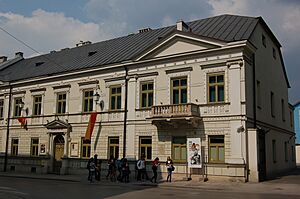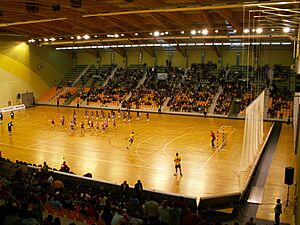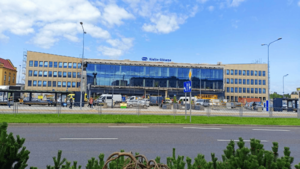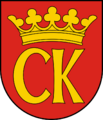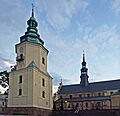Kielce facts for kids
Quick facts for kids
Kielce
|
|||
|---|---|---|---|
|
|||
|
|||
| Country | |||
| Voivodeship | |||
| County | city county | ||
| Established | 11th century | ||
| Town rights | before 1259 | ||
| Area | |||
| • Total | 109.65 km2 (42.34 sq mi) | ||
| Highest elevation | 408 m (1,339 ft) | ||
| Lowest elevation | 260 m (850 ft) | ||
| Population
(31 December 2021)
|
|||
| • Total | 192,468 |
||
| • Density | 1,780/km2 (4,600/sq mi) | ||
| Time zone | UTC+1 (CET) | ||
| • Summer (DST) | UTC+2 (CEST) | ||
| Postal code |
25-001 to 25-900
|
||
| Area code(s) | +48 41 | ||
| ISO 3166 code | PL-KI | ||
| Car plates | TK | ||
| Highways | |||
| Website | http://www.kielce.eu | ||
Kielce is a city in south-central Poland. It is the capital of the Świętokrzyskie Voivodeship (a region in Poland). In 2021, about 192,468 people lived there. The city is located in the middle of the Świętokrzyskie Mountains (Holy Cross Mountains). It sits on the banks of the Silnica River.
Kielce has a long history, going back over 900 years. No one knows the exact date it was founded. The area around Kielce is rich in natural resources like copper, lead, and iron. For centuries, these resources were mined on a large scale. Kielce was once an important center for limestone mining.
The city hosts many fairs and exhibitions throughout the year. One of its most famous food products is Kielecki Mayonnaise. Kielce is also known for its historic buildings and green spaces. The Świętokrzyski National Park is a popular recreational area nearby. In sports, Kielce is home to Vive Kielce, a top handball club. They have won many Polish championships and even the EHF Champions League.
Contents
- What's in a Name? The Etymology of Kielce
- Kielce Through Time: A Brief History
- Kielce's Weather: Climate and Seasons
- Exploring Kielce: Tourist Attractions
- Learning in Kielce: Education
- People of Kielce: Demographics
- Arts and Sports: Culture in Kielce
- Getting Around: Transport in Kielce
- Famous People from Kielce
- Global Connections: International Relations
- Images for kids
- See also
What's in a Name? The Etymology of Kielce
The name Kielce has a few interesting stories behind it. One local legend tells of Mieszko II Lambert, a Polish prince. While hunting, he fell asleep and dreamed of being attacked. In his dream, Saint Adalbert appeared and showed him a stream. When Mieszko woke up, he found the Silnica River and felt stronger. He also found white tusks, possibly from a wild boar. Mieszko decided to build a town and a church to St. Adalbert there. The legend says the name Kielce comes from these mysterious tusks (kieł means "tusk" in Polish).
Other stories suggest different origins. One idea is that the town was named after its founder, who belonged to a noble family called Kiełcz. Another theory connects the name to the Celts, who might have lived in the area long ago. Some believe it relates to old words for mud huts or iron tips for weapons.
The most likely explanation is that the name comes from an old Polish word, kielce. This word means "sprout" and refers to plants growing in the wet areas where the settlement was built. The first time the name Kielce was written down was in a document from 1213.
Kielce Through Time: A Brief History

People have lived in the Kielce area since at least 500 BC. Around the 6th or 7th century, a group called the Celts lived by the Silnica River. Later, a Lechitic tribe called the Vistulans settled there. These lands eventually became part of the growing Polish state under the Piast dynasty.
The Holy Cross Mountains area was mostly empty until the 11th century. Hunters started to build permanent homes there. They needed a place to trade their furs and meat for food, so the market of Kielce began. In the early 12th century, the settlement became owned by the Bishops of Kraków. They built a wooden church and a manor house. A stone church was built in 1171. By 1295, Kielce was officially granted city rights. The town was damaged by the Mongol invasion in the mid-13th century but quickly recovered.
Kielce was part of the Sandomierz Voivodeship within the Polish Kingdom. The area was rich in minerals like copper and iron. In the 15th century, Kielce became an important center for making metal goods. There were also glass factories and armor shops. A beautiful Mannerist palace was built near the market between 1637 and 1642. This palace is one of the few examples of French Renaissance style buildings in Poland that survived World War II.
During a period called The Deluge, Swedish forces attacked and burned the town. Only the palace and the church survived. Kielce recovered and grew again. In 1761, over 4,000 people lived in Kielce. In 1789, the city became nationalized, meaning it was controlled by the state. Citizens gained the right to choose their own representatives. The city's economy grew quickly, with new factories and a hospital.
Foreign Rule and Uprisings

After the Third Partition of Poland, Kielce was taken over by Austria. Later, it became part of the Duchy of Warsaw under Napoleon. After Napoleon's defeat, it joined Russian-controlled Congress Poland. For a short time, Kielce was the capital of the Kraków Voivodeship. Thanks to Stanisław Staszic, Kielce became a center for industry. The town grew with new mines and factories. In 1816, the first Polish technical university was founded in Kielce. However, the industrial area declined after Staszic's death.
Many people from Kielce fought in the November Uprising against Russia in 1830. In 1863, Kielce also took part in the January Uprising. As a punishment, Russian authorities closed Polish schools and made Kielce a military city. The Polish language was banned. Students and factory workers joined the 1905 Revolution to protest these actions.
Modern Kielce: Wars and Changes
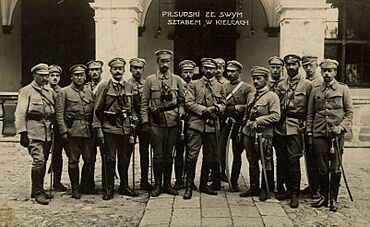
When World War I began, Kielce was the first Polish city freed from Russian rule. This was done by the Polish Legions led by Józef Piłsudski. After the war, Poland became independent again. Kielce became the capital of its own region. The city became a key part of Poland's industrial plans, with large factories like the "Granat" munitions factory.
During the Second World War, Kielce was an important center for the Polish resistance. Many resistance groups were active there. After the German invasion in 1939, German forces committed terrible acts against the people. They also set up a temporary camp for Polish prisoners of war. Local Poles helped these prisoners by providing food and medicine.
The Germans carried out mass arrests of Poles, including teachers and priests. Many arrested Poles were sent to concentration camps or killed. For example, 63 people were massacred at a local stadium in June 1940.
Brave acts of resistance took place in Kielce. Partisans stole TNT from a factory to make grenades. Members of the resistance also escaped from jail. There were attacks on German officials and collaborators. The underground University of the Western Lands secretly taught students in Kielce.
From 1942 to 1944, the Germans also ran a camp for Soviet prisoners of war. In 1944, after the Warsaw Uprising, thousands of people from Warsaw were sent to Kielce by the Germans. Many of them were elderly, sick, or women with children.
The forests of the Holy Cross Mountains were a hub for partisan fighters. These fighters battled the Germans and helped free their towns and cities in January 1945. Many people from Kielce died during the war. After the war, Kielce was returned to Poland, but with a Soviet-backed government. In August 1945, Polish resistance fighters freed about 350 prisoners from the Kielce Prison.
Jewish Community in Kielce
Before World War II, Kielce had a large Jewish population. In 1897, about 6,400 Jews lived in the city. By the start of World War II, there were about 18,000 Jewish people. After the German invasion, more Jewish people were forced to move to Kielce.
In April 1941, the Kielce Ghetto was created. It was surrounded by fences and guards. Jewish people were forced to move into this small, crowded area. By August 1942, about 27,000 prisoners were crammed into the ghetto. Many died from hunger and disease.
During August 1942, the Kielce Ghetto was emptied over five days. Most of the Jewish people, around 20,000 to 21,000, were put on trains and sent to the Treblinka extermination camp, where they were killed. Only about 2,000 Jewish people were left in Kielce, forced to work in labor camps. On May 23, 1943, German police killed 45 Jewish children who had survived the ghetto's emptying.
After the war, on July 4, 1946, a group of about 200 Jewish survivors gathered at a refugee center. They became the target of the Kielce pogrom. In this event, 37 to 40 Jewish people and 2 ethnic Poles were killed. Many Jewish people left Poland after this event. Poland was the only country in the Eastern Bloc that allowed Jewish people to move freely to the new State of Israel after World War II.
Kielce's Weather: Climate and Seasons
| Weather chart for Kielce | |||||||||||||||||||||||||||||||||||||||||||||||
|---|---|---|---|---|---|---|---|---|---|---|---|---|---|---|---|---|---|---|---|---|---|---|---|---|---|---|---|---|---|---|---|---|---|---|---|---|---|---|---|---|---|---|---|---|---|---|---|
| J | F | M | A | M | J | J | A | S | O | N | D | ||||||||||||||||||||||||||||||||||||
|
34
0
-5
|
29
1
-5
|
35
6
-2
|
39
14
3
|
53
19
8
|
71
21
11
|
81
24
13
|
77
23
12
|
56
19
8
|
42
13
4
|
40
6
0
|
44
1
-3
|
||||||||||||||||||||||||||||||||||||
| temperatures in °C precipitation totals in mm |
|||||||||||||||||||||||||||||||||||||||||||||||
|
Imperial conversion
|
|||||||||||||||||||||||||||||||||||||||||||||||
Kielce has four clear seasons. It has a humid continental climate, which is common in this part of Europe. Winters are cool and cloudy, with light snowfall almost every day. Temperatures are usually around freezing. Summers are moderately warm and sunny. There are often thunderstorms, which can sometimes be strong.
Because Kielce is surrounded by the Holy Cross Mountains, summer nights are a bit cooler. Also, thunderstorms can be more frequent and severe here than in other parts of Poland. The weather can change a lot from year to year. This is especially true in winter, depending on whether the air comes from the ocean or from the continent.
Ocean air usually brings cool, cloudy, and foggy weather in both summer and winter. Air from the continent often brings long periods of sunny and dry weather. This means hot summers and sometimes very cold winters.
The highest temperature ever recorded in Kielce since 1971 was 36.4°C (97.5°F). The lowest was -33.9°C (-29.0°F). This shows a very wide range of temperatures. The city gets about 1720 to 1829 hours of sunshine each year. Spring and summer are very sunny, while late autumn and winter are cloudy. Winds are usually very light. This means that even when it's cold, it might not feel as chilly because there's less wind.
Winter weather changes a lot each year. For example, January 2006 was very cold, with temperatures dropping to -30°C (-22°F). But January 2007 was much milder, with temperatures sometimes going above 10°C (50°F). Heavy snowfall is rare. Snow usually builds up slowly, a few centimeters at a time.
Summer is warm and lasts from June to early September. It has lots of sunshine but also strong storms, especially early in the season. Average temperatures are in the low to mid-20s Celsius (70s Fahrenheit). Hot spells often reach around 30°C (86°F). These hot periods are often broken up by cold fronts, which bring thunderstorms and cooler weather.
Spring and autumn are unpredictable. Temperatures can swing widely. Nice weather around 20°C (68°F) can happen as early as March and as late as October. But there can also be much colder periods. Frost can occur at night as early as September and as late as May.
Exploring Kielce: Tourist Attractions
Kielce has many interesting places to visit:
- Palace of the Kraków Bishops in Kielce (1637–1641): This was the summer home of the Bishops of Kraków. It's a beautiful early baroque building. Today, it's a museum with a great collection of Polish paintings.
- Baroque Cathedral (12th century): This old church has been rebuilt several times.
- Old Town market (18th century): This historic market square has a neoclassicist town hall.
- Sienkiewicza Street: A popular street in the city.
- Holy Trinity Church (1640–1644).
- St. Adalbert Church: This church dates back to the 10th century.
- Tomasz Zieliński romantic manor (1846–1858).
- Former synagogue: Built in 1902.
- Garrison Catholic Church of Our Lady Queen of Poland: This church was built between 1902 and 1904.
- Exaltation of the Holy Cross church: Built in Gothic Revival style (1903–1913).
- Bank building at 47 Sienkiewicza Street: Built in Art Nouveau style (1911-1912).
- Socialist realist building of the Jan Kochanowski University: This was once the regional headquarters of a political party.
- Modernist bus station: Built between 1975 and 1984.
- Many monuments: These include statues of famous people like Henryk Sienkiewicz, Józef Piłsudski, and Pope John Paul II.
- Homo Homini monument: This was the first monument in Europe to remember the victims of the September 11 attacks.
- Geopark Kielce with the Center of Geoeducation.
- 5 geological nature reserves within the city.
Learning in Kielce: Education
Kielce has several universities and schools:
- Kielce University of Technology (Politechnika Świętokrzyska)
- Jan Kochanowski University (Uniwersytet Jana Kochanowskiego)
- Świętokrzyska Szkoła Wyższa
- Wszechnica Świętokrzyska
- Wyzsza Szkola Administracji Publicznej
- Wyzsza Szkola Ekonomii i Prawa im. prof. Edwarda Lipinskiego
- Wyzsza Szkola Handlowa im. Boleslawa Markowskiego
- Wyzsza Szkola Umiejetnosci
- Wyzsza Szkola Technik Komputerowych i Telekomunikacji
- Wyzsza Szkola Zarzadzania Gospodarka Regionalna i Turystyka
- Wyzsza Szkola Telekomunikacji i Informatyki
- Towarzystwo Wiedzy Powszechnej OR, Kielce
- High schools, including:
- Juliusz Słowacki High School No. 6
- Stefan Żeromski High School No. 1
- Jan Śniadecki High School No. 2
People of Kielce: Demographics
As of December 31, 2020, there were 193,415 people living in Kielce. The unemployment rate in June 2021 was 5.0%. The average income per person was PLN 4798.67 gross.
- A graph showing Kielce's population over the past 4 centuries:
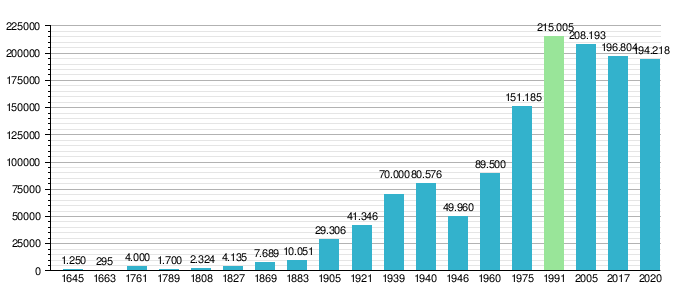
Arts and Sports: Culture in Kielce

Museums and Theatres
Kielce has several museums where you can learn about history and art:
- National Museum in Kielce: This museum has a collection of fine arts.
- Kielce History Museum.
- Museum of Toys and Play.
- Laurens Hammond Museum.
- Stefan Żeromski's School Years museum.
The city also has a lively theatre scene:
- Stefan Żeromski Theatre.
- Kieleckie Centrum Kultury - KCK.
- Teatr Lalki i Aktora "Kubuś" - Puppet and Actor Theatre "Kubuś".
- Kielecki Teatr Tańca - Kielce Dance Theatre.
Sports Teams and Clubs
Kielce is known for its sports teams:
| Club | Sport | League | Trophies |
|---|---|---|---|
| Barlinek Industria Kielce | Men's handball | Superliga | 20 Polish Championships 17 Polish Cups 1 EHF Champions League (2016) |
| Korona Kielce | Men's football | Ekstraklasa | 0 |
| Korona Handball Kielce | Women's handball | Liga Centralna Kobiet | 0 |
Other sports clubs in Kielce include:
- KKL Kielce (athletics).
- Oficina da Capoeira Kielce (Capoeira Club).
- Muay Thai Kielce.
- Żak Kielce (judo club).
- Kielecki Klub Karate Kyokushin.
- Rushh Kielce (boxing club).
- Gwardia Kielce (boxing club).
- Orlęta Kielce (football club).
- Jokers Kielce (American football).
- Tęcza Kielce.
- Tor Kielce circuit in Miedziana Góra.
- Mountain biking in Kielce.
- Contact Kielce billiards club.
Getting Around: Transport in Kielce
Kielce is an important place for travel. It is located on major roads for both national and international journeys.
Roads and Highways
Important roads passing through or near Kielce include:
- Invalid type: DK Invalid type: S This road connects Gdańsk in the north to Kraków in the south.
- Invalid type: DK This road goes from Wiśniówka through Kielce to Jasło.
- Invalid type: DK Invalid type: S This road connects Sulejów to Kielce and then to Zamość.
Kielce also has a network of local roads. About 57.5% of the roads in the city have a good paved surface.
Trains and Railways
Trains first came to Kielce in 1885. Today, Kielce is a key railway hub. Train lines connect it to cities like Warsaw, Kraków, and Częstochowa. There are several train stations within the city limits.
Air Travel
Kielce has a civilian airport called Kielce-Masłów Airport. It is located in nearby Masłów. However, its runway is too short for large passenger planes. Plans are being made for a new, larger airport near Obice Morawica. The closest international airports are in Kraków-Balice, Warsaw-Okecie, and Rzeszów-Jasionka.
City Buses
Public bus services started in Kielce on July 22, 1951. Today, the city has many bus lines. These include regular lines, "EU" lines, hybrid lines, and night lines. Most buses are operated by the Municipal Transport Company (MPK Kielce). The city is also adding new, modern buses and electronic boards at bus stops.
Famous People from Kielce
Many notable people have connections to Kielce:
- Stanisław Staszic (1755–1826): A priest, philosopher, and writer. He was a leader of the Polish Enlightenment.
- Adolf Dygasiński (1839–1902): A famous novelist.
- Stefan Żeromski (1864–1925): A novelist and dramatist, known as the "conscience of Polish literature."
- Gustaw Herling-Grudziński (1919–2000): A writer and journalist who fought in World War II.
- Gershon Iskowitz (1921–1988): A Canadian artist.
- Edmund Niziurski (1925–2013): A writer.
- Wiesław Gołas (1930-2021): A well-known actor.
- Thomas Buergenthal (1934-2023): An American judge who lived in the Kielce Ghetto.
- Rafał Olbiński (born 1943): A graphic artist and painter.
- Włodzimierz Pawlik (born 1958): A Grammy Award-winning jazz pianist.
- Krzysztof Klicki (born 1962): A businessman and former owner of Korona Kielce.
- Michał Sołowow (born 1962): A businessman and rally driver, one of the richest Poles.
- Piotr Marzec (born 1971): Better known as Liroy, a rapper.
- Andrzej Piaseczny (born 1971): A popular vocalist.
- Dagmara Domińczyk (born 1976): A Polish-American actress and author.
- Marika Domińczyk (born 1980): A Polish-American actress.
- Rafał Zawierucha (born 1986): An actor who grew up in Kielce.
Sports Figures
- Leszek Drogosz (1933–2012): A boxer, three-time European Champion, and Olympic medalist.
- Zbigniew Piątek (born 1966): A cyclist.
- Piotr Stokowiec (born 1972): A football manager.
- Paweł Brożek (born 1983): A footballer.
- Piotr Brożek (born 1983): A footballer.
Global Connections: International Relations
Consulates in Kielce
Kielce hosts honorary consulates for Finland, Germany, and Hungary.
Sister Cities
Kielce is connected with other cities around the world as "twin towns" or "sister cities":
Images for kids
See also
 In Spanish: Kielce para niños
In Spanish: Kielce para niños


